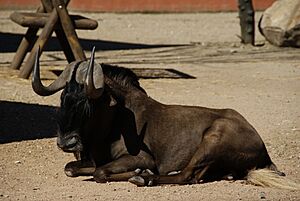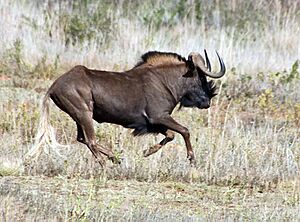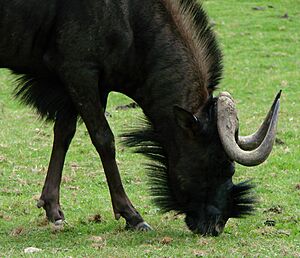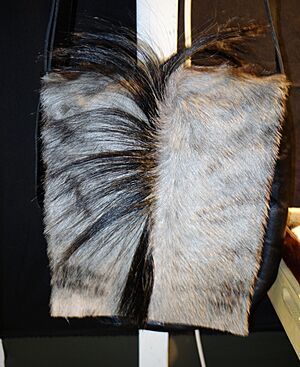Black wildebeest facts for kids
The black wildebeest or white-tailed gnu (Connochaetes gnou) is a type of wildebeest. It belongs to the same animal family as cows, called Bovidae. This animal was first described in 1780. Black wildebeest are usually about 170 to 220 cm (67 to 87 in) long from head to body. They typically weigh between 110 and 180 kg (240 to 400 lb). Males are taller, standing about 111 to 121 cm (44 to 48 in) at the shoulder. Females are a bit shorter, at 106 to 116 cm (42 to 46 in).
A special feature of the black wildebeest is its long, white, horse-like tail. They have a dark brown to black coat. They also have long, dark hair between their front legs and under their belly.
Black wildebeest are herbivores, meaning they eat plants. Most of their diet is grass. They need water to survive. They live in three main groups: female herds, groups of young males, and male wildebeest that have their own territories. They can run very fast. They talk to each other using different sounds and body language. The main time for them to have babies is from February to April. A single baby is usually born after about 8 and a half months. The baby stays with its mother until her next baby is born a year later. Black wildebeest live in open plains, grasslands, and areas with small shrubs called karoo.
In the 1800s, most wild black wildebeest were almost wiped out. People hunted them because they thought they were pests and because their hides and meat were valuable. But now, the species has been brought back. This happened by releasing animals from zoos and special breeding programs. You can find them in nature reserves and private areas in Lesotho, Eswatini, and South Africa. They have also been introduced to Namibia and Kenya, outside their original home.
Quick facts for kids Black wildebeest |
|
|---|---|
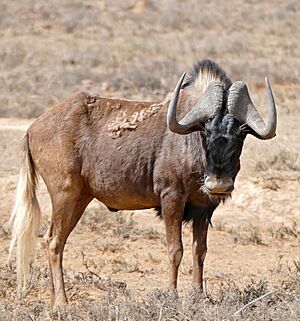 |
|
| Black wildebeest in Mountain Zebra National Park, South Africa | |
| Conservation status | |
| Scientific classification | |
 |
|
| Distribution range | |
| Synonyms | |
|
Contents
Understanding the Black Wildebeest Name
The scientific name for the black wildebeest is Connochaetes gnou. It was first described by a German zoologist named Eberhard August Wilhelm von Zimmermann in 1780. The name Connochaetes comes from Greek words meaning "beard" and "flowing hair." The word gnou comes from the Khoikhoi language, which is what the local people called these animals. The common name "gnu" also comes from this language.
The black wildebeest is related to the blue wildebeest (Connochaetes taurinus). Scientists believe the black wildebeest became a separate species about a million years ago. This is quite recent in Earth's long history.
Wildebeest Hybrids
Black wildebeest can breed with blue wildebeest. This creates hybrid offspring. This usually happens when both types of wildebeest are kept in the same area. The baby wildebeest born from this mix are usually able to have their own babies later.
Studies of these hybrid animals have shown some problems. Many hybrids have unusual teeth, horns, or skull bones. Some hybrids can also grow larger than either of their parents.
Physical Features of the Black Wildebeest
Female black wildebeest are usually a bit smaller and thinner than males. The total length of their body is typically between 170 and 220 cm (67 and 87 in). Males stand about 111 to 121 cm (44 to 48 in) tall at the shoulder. Females are 106 to 116 cm (42 to 46 in) tall. Males usually weigh 140 to 157 kg (309 to 346 lb), and females weigh 110 to 122 kg (243 to 269 lb).
A key feature of both male and female black wildebeest is their long, horse-like tail. This tail is bright white, which is why they are also called "white-tailed gnu." This white tail helps tell them apart from the blue wildebeest, which has a black tail. The tail can be 80 to 100 cm (31 to 39 in) long.
Their fur is dark brown or black. It looks a bit lighter in summer and becomes rougher and shaggier in winter. Baby wildebeest are born with shaggy, light brown fur. Males are generally darker than females. They have bushy, dark-tipped manes that stand up from their neck, just like blue wildebeest. They also have black, bristly hair on their muzzle and under their jaw. Long, dark hair grows between their front legs and under their belly. They have a thick neck and small, beady eyes.
Both male and female black wildebeest have strong horns. These horns curve forward, looking like hooks. They can be up to 78 cm (31 in) long. In adult males, the horns have a wide base that forms a protective shield. Female horns are shorter and narrower. Horns are fully grown in females by age three, and in males by age four or five.
Black wildebeest can keep their body temperature steady even when the outside temperature changes a lot. They are good at facing the sun to help them stay cool in hot, open areas. They can live for about 20 years.
Black Wildebeest Behavior and Habitat
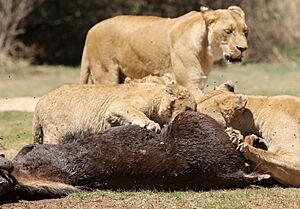
Black wildebeest are most active in the early morning and late afternoon. They prefer to rest during the hottest part of the day. These animals are very fast, able to run at speeds up to 80 km/h (50 mph). If you get too close to a herd, they will snort and run a short distance before stopping to look back. They repeat this if you keep approaching.
They communicate using special smells (pheromones) and different sounds. One sound is a metallic snort or an echoing "hick," which can be heard up to 1.5 km (1 mi) away. Their main predators are lions, spotted hyenas, Cape wild dogs, leopards, cheetahs, and Nile crocodiles. Hyenas mostly hunt the young calves, while lions usually attack the adult wildebeest.
Black wildebeest are social animals. They live in three main types of groups:
- Female herds: These groups include adult females and their young. There can be 14 to 32 females in a herd. Members of these herds are often related and stay close to each other. Young males usually leave their mothers before the new babies are born.
- Bachelor herds: These groups are made up of young males and older males. They are usually loose groups, and the males don't have strong bonds with each other. These herds roam widely and can be a safe place for males that haven't found their own territory yet.
- Territorial bulls: These are mature male wildebeest, usually over 4 years old. They claim their own areas, called territories. Female herds often pass through these territories. Bulls keep their territories all year. They have a special spot in the middle of their territory where they regularly leave their droppings. They also perform displays like urinating, scraping the ground, pawing, and rolling. These actions show other bulls how strong they are. When two bulls meet, they have special rituals before they fight. They might lower their heads, circle each other, or push horns.
What Black Wildebeest Eat
Black wildebeest mostly eat short grasses. But they can also eat other plants and shrubs, especially when grass is hard to find. Shrubs can make up to 37% of their diet, but usually, grass is more than 90%. They need water, but they don't have to drink every single day. Herds graze in lines or loose groups. They often walk in a single file when moving. You might see cattle egrets with them. These birds eat insects that the wildebeest stir up or that are on their coats.
In the past, black wildebeest moved around a lot, following the rains and looking for good grass. They didn't travel as far as blue wildebeest, but they did cross mountains to find pastures. Now, most black wildebeest live on farms or in protected areas, so their movements are limited.
Black Wildebeest Life Cycle and Reproduction
Male black wildebeest are ready to mate when they are 3 years old. Females can start having babies when they are one or two years old. They only have babies once a year.
A strong male wildebeest will have a group of females (a harem) and won't let other males mate with them. The mating season happens at the end of the rainy season, usually between February and April.
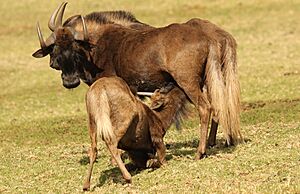
The mother carries the baby for about 8.5 months. Then, a single calf is born. Mothers usually give birth in areas with short grass while lying down. She stands up right after birth, which breaks the umbilical cord. She then licks the calf and eats the afterbirth. About 80% of females give birth within a 2–3 week period after the rainy season starts, from mid-November to late December.
A newborn calf has tawny, shaggy fur and weighs about 11 kg (24 lb). By four weeks old, their front teeth are fully out. Around the same time, two small bumps, which will become horns, appear on their head. These horns grow to 200–250 mm (8–10 in) by five months and are well developed by eight months. The calf can stand and run very soon after birth. This is important because it's a dangerous time for young animals in the wild. The mother feeds the calf milk for 6–8 months. The calf starts nibbling on grass at 4 weeks old. It stays with its mother until her next calf is born a year later.
Where Black Wildebeest Live
The black wildebeest is originally from southern Africa. Historically, they lived in South Africa, Eswatini, and Lesotho. However, they were hunted so much in Eswatini and Lesotho that they disappeared in the 1800s. Now, they have been brought back to these countries. They have also been introduced to Namibia, where they are doing very well.
Black wildebeest live in open plains, grasslands, and areas with karoo shrubs. These places can be steep mountains or rolling hills. They live at altitudes from 1350 to 2150 m (4,430 to 7,050 ft). Herds often move around or have regular home ranges of about 1 km2 (0.39 sq mi). Female herds roam in larger areas, about 250 acres (100 ha).
In the past, black wildebeest lived in temperate grasslands during the dry winter and in the dry karoo region during the rains. But because of a lot of hunting, they are now mostly found on game farms and in protected reserves in southern Africa. In most reserves, they share their home with other animals like the blesbok and the springbok.
Protecting the Black Wildebeest
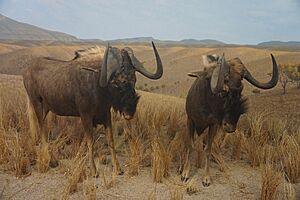
One potential threat to black wildebeest is that they can breed with blue wildebeest where they live together. This can make it harder to keep the two species distinct.
Black wildebeest were once very common, with huge herds in Southern Africa. But by the late 1800s, they were almost hunted to extinction. Fewer than 600 animals were left. Luckily, a small number of these animals were in game reserves and zoos. From these few, the population was saved.
Today, there are believed to be more than 18,000 black wildebeest. About 7,000 of them are in Namibia, which is outside their original home. Most wildebeest (about 80%) live on private land, and the other 20% are in protected areas. The population is growing, especially on private land. Because of this, the International Union for Conservation of Nature (IUCN) now lists the black wildebeest as a species of least concern. This means they are not currently at high risk of extinction. Their introduction to Namibia has been very successful, with numbers growing from 150 in 1982 to 7,000 in 1992.
Black Wildebeest and People
The black wildebeest is an important symbol in South Africa. It is shown on the coat of arms of the former Natal Province. South Africa has also issued stamps and even a 5-rand coin featuring a black wildebeest.
While they are not as numerous in the wild as they once were, black wildebeest used to be a main food source for large predators like lions. Today, they are important for people because they attract tourists. They also provide products like leather and meat. Their hide makes good quality leather. Their meat is often dried to make biltong, a popular South African snack. Female meat is usually more tender than male meat.
However, black wildebeest can also cause problems for humans. Wild wildebeest can compete with farm animals for food. They can also carry diseases that can spread to livestock, like cattle. They can also spread ticks and other parasites.



